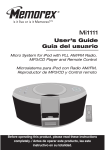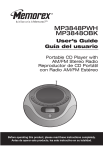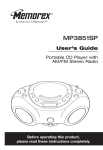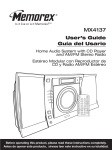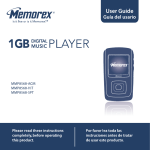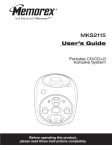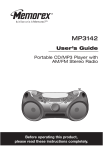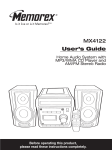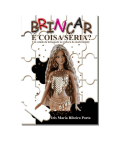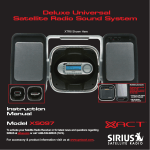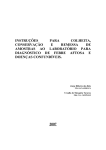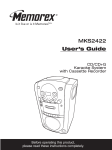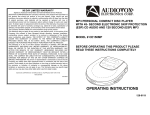Download Memorex MP4047 CD Player User Manual
Transcript
MP4047 User’s Guide Guía del usuario Portable CD/MP3/WMA Player with AM/FM Stereo Radio Reproductor de CD/MP3/WMA Portátil con Radio AM/FM Estéreo Before operating this product, please read these instructions completely. Antes de operar este producto, lea este instructivo en su totalidad. Dear Customer, Please read this manual thoroughly before operating the unit to become more familiar with it and obtain the performance that will bring you continued enjoyment for many years. Keep these instructions handy for future reference. PLEASE KEEP ALL PACKAGING MATERIAL FOR AT LEAST 90 DAYS IN CASE YOU NEED TO RETURN THIS PRODUCT TO YOUR PLACE OF PURCHASE OR MEMOREX. For future reference, record the serial number of the unit printed on the rear of the cabinet. Serial Number _______________________________________ SAFETY PRECAUTIONS CAUTION RISK OF ELECTRIC SHOCK DO NOT OPEN CAUTION: TO REDUCE THE RISK OF ELECTRIC SHOCK, DO NOT REMOVE COVER (OR BACK). NO USER-SERVICEABLE PARTS INSIDE. REFER SERVICING TO QUALIFIED SERVICE PERSONNEL. (This Caution Marking and Rating Label are located at the rear bottom enclosure of the unit.) DANGEROUS VOLTAGE: The lightning flash with arrowhead symbol within an equilateral triangle is intended to alert the user to the presence of uninsulated dangerous voltage within the product’s enclosure that may be of sufficient magnitude to constitute a risk of electric shock to persons. ATTENTION: The exclamation point within an equilateral triangle is intended to alert the user to the presence of important operating and maintenance (servicing) instructions in the literature accompanying the appliance. DANGER: Invisible and hazardous laser radiation when open and interlock failed or defeated. Avoid direct exposure to beam. FCC WARNING: This equipment may generate or use radio frequency energy. Changes or modifications to this equipment may cause harmful interference unless the modifications are expressly approved in the instruction manual. The user could lose the authority to operate this equipment if an unauthorized change or modification is made. 1 SAFETY PRECAUTIONS INFORMATION: This equipment has been tested and found to comply with the limits for a Class B digital device, pursuant to Part 15 of the FCC Rules. These limits are designed to provide reasonable protection against harmful interference in a residential installation. This equipment generates, uses and can radiate radio frequency energy and, if not installed and used in accordance with the instructions, may cause harmful interference to radio communications. However, there is no guarantee that interference will not occur in a particular installation. If this equipment does cause harmful interference to radio or television reception, which can be determined by turning the equipment off and on, the user is encouraged to try to correct the interference by one or more of the following measures: • Reorient or relocate the receiving antenna. • Increase the separation between the equipment and receiver. • Connect the equipment into an outlet on a circuit different from that to which the receiver is connected. • Consult the dealer or an experienced radio/TV technician for help. WARNING: TO PREVENT FIRE OR SHOCK HAZARD, DO NOT EXPOSE THIS UNIT TO RAIN OR MOISTURE. LASER SAFETY: This unit employs a laser. Only qualified service personnel should attempt to service this device due to possible eye injury. CAUTION: USE OF CONTROLS, ADJUSTMENTS OR PERFORMANCE PROCEDURE HEREIN MAY RESULT IN HAZARDOUS RADIATION EXPOSURE. SURGE PROTECTORS: It is recommended to use a surge protector for AC connection. Lightning and power surges ARE NOT covered under warranty for this product. ATTENTION: POUR ÉVITER LES CHOC ÉLECTRIQUES, INTRODUIRE LA LAME LA PLUS LARGE DE LA FICHE DANS LA BORNE CORRESPONDANTE DE LA PRISES ET POUSSER JUSQU’AU FOND. This Class B digital apparatus complies with Canadian ICES-003. Cet appareil numérique de la classe B est conforme à la norme NMB-003 du Canada. 2 Dear Customer: Selecting fine audio equipment such as the unit you’ve just purchased is only the start of your musical enjoyment. Now it’s time to consider how you can maximize the fun and excitement your equipment offers. This manufacturer and the Electronic Industries Association’s Consumer Electronics Group want you to get the most out of your equipment by playing it at a safe level. One that lets the sound come through loud and clear without annoying blaring or distortion and, most importantly, without affecting your sensitive hearing. Sound can be deceiving. Over time your hearing “comfort level” adapts to higher volumes of sound. So what sounds “normal” can actually be loud and harmful to your hearing. Guard against this by setting your equipment at a safe level BEFORE your hearing adapts. To establish a safe level: • Start your volume control at a low setting. • Slowly increase the sound until you can hear it comfortably and clearly, and without distortion. Once you have established a comfortable sound level: • Set the dial and leave it there. Taking a minute to do this now will help to prevent hearing damage or loss in the future. After all, we want you listening for a lifetime. We Want You Listening For A Lifetime Used wisely, your new sound equipment will provide a lifetime of fun and enjoyment. Since hearing damage from loud noise is often undetectable until it is too late, this manufacturer and the Electronic Industries Association’s Consumer Electronics Group recommend you avoid prolonged exposure to excessive noise. This list of sound levels is included for your protection. Decibel Level 30 40 50 60 70 80 Example Quiet library, soft whispers Living room, refrigerator, bedroom away from traffic Light traffic, normal conversation, quiet office Air conditioner at 20 feet, sewing machine Vacuum cleaner, hair dryer, noisy restaurant Average city traffic, garbage disposals, alarm clock at two feet THE FOLLOWING NOISES CAN BE DANGEROUS UNDER CONSTANT EXPOSURE: C IND U TR N A EST. 1924 O O C I A TI IES EIA S S 3 NI S Information courtesy of the Deafness Research Foundation. O R Subway, motorcycle, truck traffic, lawn mower Garbage truck, chain saw, pneumatic drill Rock band concert in front of speakers, thunderclap Gunshot blast, jet engine Rocket launching pad ELECT 90 100 120 140 180 We Want You LISTENING For A Lifetime SAFETY INSTRUCTIONS Before using the unit, be sure to read all operating instructions carefully. Please note that these are general precautions and may not pertain to your unit. For example, this unit may not have the capability to be connected to an outdoor antenna. 1. READ INSTRUCTIONS All the safety and operating instructions should be read before the product is operated. 2. RETAIN INSTRUCTIONS The safety and operating instructions should be retained for future reference. 3. HEED WARNINGS All warnings on the product and in the operating instructions should be adhered to. 4. FOLLOW INSTRUCTIONS All operating and use instructions should be followed. 5. CLEANING Unplug this product from the wall outlet before cleaning. Do not use liquid cleaners or aerosol cleaners. Use a dry cloth for cleaning. 6. ATTACHMENTS Do not use attachments not recommended by the product's manufacturer as they may cause hazards. 7. WATER AND MOISTURE Do not use this product near water–for example: near a bathtub, washbowl, kitchen sink or laundry tub; in a wet basement; or near a swimming pool. 8. ACCESSORIES Do not place this product on an unstable cart, stand, tripod, bracket or table. The product may fall, causing serious injury and serious damage to the product. Use only with a cart, stand, tripod, bracket or table recommended by the manufacturer or sold with the product. Any mounting of the product should follow the manufacturer’s instructions, and should use a mounting accessory recommended by the manufacturer. 8A. An appliance and cart combination should be moved with care. Quick stops, excessive force and uneven surfaces may cause the appliance and cart combination to overturn. 9. VENTILATION Slots and openings in the cabinet and in the back or bottom are provided for ventilation, to ensure reliable operation of the product and to protect it from overheating. These openings must not be blocked or covered. The openings should never be blocked by placing the product on a bed, sofa, rug or other similar surface. This product should never be placed near or over a radiator or heat source. This product should not be placed in a built-in installation such as a bookcase or rack unless proper ventilation is provided or the manufacturer's instructions have been adhered to. 10. POWER SOURCES This product should be operated only from the type of power source indicated on the marking label. If you are not sure of the type of power supply to your home, consult your appliance dealer or local power company. For products intended to operate from battery power, or other sources, refer to the operating instructions. 11. GROUNDING OR POLARIZATION This product is equipped with a polarized alternating-current line plug (a plug having one blade wider than the other). This plug will fit into the power outlet only one way. This is a safety feature. If you are unable to insert the plug fully into the outlet, try reversing the plug. If the plug should still fail to fit, contact your electrician to replace your obsolete outlet. Do not defeat the safety purpose of the polarized plug. 12. POWER-CORD PROTECTION Power-supply cords should be routed so that they are not likely to be walked on or pinched by items placed upon or against them, paying particular attention to cords at plugs, convenience receptacles, and the point where they exit from the appliance. 13. LIGHTNING To protect your product from a lightning storm, or when it is left unattended and unused for long periods of time, unplug it from the wall outlet and disconnect the antenna or cable system. This will prevent damage to the product due to lightning and power-line surges. 14. POWER LINES An outside antenna system should not be located in the vicinity of overhead power lines or other electric light or power circuits, or where it can fall into such power lines or circuits. When installing an outside antenna system, extreme care should be taken to keep from touching such power lines or circuits as contact with them might be fatal. 4 SAFETY INSTRUCTIONS (CONTINUED) 15. OVERLOADING Do not overload wall outlets and extension cords as this can result in a risk of fire or electric shock. 16. OBJECT AND LIQUID ENTRY Never push objects of any kind into this product through openings as they may touch dangerous voltage points or short out parts that could result in fire or electric shock. Never spill or spray any type of liquid on the product. 17. OUTDOOR ANTENNA GROUNDING If an outside antenna is connected to the product, be sure the antenna system is grounded so as to provide some protection against voltage surges and builtup static charges. Section 810 of the National Electric Code, ANSI/NFPA 70, provides information with respect to proper grounding of the mast and supporting structure, grounding of the lead-in wire to an antenna discharge product, size of grounding conductors, location of antenna discharge product, EXAMPLE OF ANTENNA GROUNDING AS PER connection to grounding NATIONAL ELECTRICAL CODE electrodes and requirements for grounding electrodes. 18. SERVICING Do not attempt to service this product yourself as opening or removing covers may expose you to dangerous voltage or other hazards. Refer all servicing to qualified service personnel. 19. REPLACEMENT PARTS When replacement parts are required, be sure the service technician uses replacement parts specified by the manufacturer or those that have the same characteristics as the original part. Unauthorized substitutions may result in fire, electric shock or other hazards. 20. SAFETY CHECK Upon completion of any service or repairs to this product, ask the service technician to perform safety checks to determine that the product is in proper operating condition. 21. WALL OR CEILING MOUNTING The product should be mounted to a wall or ceiling only as recommended by the manufacturer. 22. DAMAGE REQUIRING SERVICE Unplug the product from the wall outlet and refer servicing to qualified service personnel under the following conditions: a. When the power-supply cord or plug is damaged. b. If liquid has been spilled or objects have fallen into the product. c. If the product has been exposed to rain or water. d. If the product does not operate normally by following the operating instructions. Adjust only those controls that are covered by the operating instructions, as an adjustment of other controls may result in damage and will often require extensive work by a qualified technician to restore the product to its normal operation. e. If the product has been dropped or the cabinet has been damaged. f. When the product exhibits a distinct change in performance–this indicates a need for service. 23. HEAT The product should be situated away from heat sources such as radiators, heat registers, stoves or other products (including amplifiers) that produce heat. 24. NOTE TO CATV SYSTEM INSTALLER This reminder is provided to call the CATV system installer's attention to Article 820-40 of the NEC that provides guidelines for proper grounding and, in particular, specifies that the cable ground shall be connected to the grounding system of the building, as close to the point of cable entry as practical. 5 MAIN UNIT 1. 2. 3. 4. 5. 6. 7. 8. LOCATION OF CONTROLS AUX IN Jack Headphones Jack Battery Compartment (Bottom of Unit) 13. Left Speaker 14. FM Antenna 15. AC Power Jack (Rear of Unit) (BATTERY COMPARTMENT DOOR PART NO. 622-05638-0010*) 16. 17. 18. 19. 20. 21. 22. 23. Carrying Handle Disc Compartment INFO Button MODE Button PROG (Program)/ MEMORY Button 9. Preset/Folder Up Button 10. PLAY/PAUSE (®p) Button 11. Skip/Search/Tune o Button 12. Display (AC CORD PART NO. 248-19052-E010*) POWER Button EQ Button FUNCTION Button CD Door OPEN Area VOLUME Up/Down Buttons Skip/Search/Tune n Button STOP (■)/BAND Button Right Speaker *Consumer Replaceable Part (See page 20 to order.) 6 POWER SOURCES This unit is designed to operate on AC household current or DC (batteries). AC Use the AC polarized line cord included with the unit for operation on AC power. Insert one end of the AC line cord into the AC power jack on the rear of the unit and the other end (with the 2 blades) into a conveniently located AC outlet having 120V, 60Hz. When the AC cord is plugged in, the batteries will AC Outlet be disconnected. NOTE: The AC plug supplied with the unit is polarized to help minimize the possibility of electric AC Plug shock. If the AC plug does not fit into a nonpolarized AC outlet, do not file or cut the wide blade. It is the user’s responsibility to have an electrician replace the obsolete outlet. BATTERY INSTALLATION To use this unit with battery power, remove the battery door on the bottom of the unit by pressing in on the tabs and then lifting the battery door off. Insert eight (8) ‘C’ size batteries following the diagram in the compartment. NOTES: • The AC power cord must be disconnected from the AC power jack on the rear of the unit in order for the unit to operate on battery power. • For longer-lasting life for the batteries, remove the batteries from the battery compartment if the unit is not to be used for a long period of time. BATTERY PRECAUTIONS Follow these precautions when using batteries in this device: 1. Use only the size and type of batteries specified. 2. Be sure to follow the correct polarity when installing the batteries as indicated in the battery compartment. Reversed batteries may cause damage to the device. 3. Do not mix different types of batteries together (e.g. Alkaline, Rechargeable and Carbon-zinc) or old batteries with fresh ones. 4. If the device is not to be used for a long period of time, remove the batteries to prevent damage or injury from possible battery leakage. 5. Do not try to recharge batteries not intended to be recharged; they can overheat and rupture. (Follow battery manufacturer’s directions.) HEADPHONES JACK (TOP OF UNIT) For private listening, connect 3.5mm (32 ohm) stereo headphones (not included) to this jack. The speakers are automatically disconnected when the headphones plug is inserted in the jack. 7 OPERATION LISTENING TO THE RADIO 1 2 1 2 Press the POWER button 1 to turn the unit on. Press the FUNCTION button 2 to select the Tuner mode. Press the STOP (■)/BAND button to select AM or FM. 3 4 1 1 2 MANUAL TUNING: Repeatedly press the Skip/Search/Tune o 1 or n 2 button to manually advance the frequency in the display up or down until the desired frequency appears. 5 2 2 AUTOMATIC TUNING: Press and hold the Skip/Search/Tune o 1 or n 2 button until the frequency in the display starts to scan, and then release the button; the tuner will search and then stop on the next strong station it finds. Repeat this step until the desired frequency appears in the display. NOTE: If you have tuned to an FM Stereo station, “STEREO” will light in the display. 6 2 1 To turn the radio off, press the POWER button again. Adjust the VOLUME Up/Down buttons 1 and EQ button 2 as desired. Repeatedly press the EQ button 2 to cycle through the following options: Classic, Pop, Jazz, Rock and Flat. ANTENNAS AM–This unit has a built-in ferrite rod antenna, which provides adequate reception in most areas. If reception is weak, turn the unit to improve reception. FM–The FM Antenna is for FM reception only. If reception is weak, adjust the length of the antenna. 8 OPERATION (CONTINUED) SETTING THE PRESETS (20 for FM, 10 for AM) 1 2 1 2 Press the POWER button 1 to turn the unit on. Press the FUNCTION button 2 to select the Tuner mode. 3 1 2 4 Select a band and tune the desired station to set into memory as described on the previous page, Steps 2-4. 4 2 Press the PROG/MEMORY button 1; the preset number will blink and MEM will appear in the display. Press the Preset/Folder Up button 2 until the desired preset number appears in the display. Press the PROG/MEMORY button again to set the station in the selected memory. Repeat steps 2 through 4 to program additional stations, if desired. NOTE: If the main power supply is interrupted, the memory presets will be erased. RECALLING RADIO PRESETS 1 2 Select the Tuner mode and the desired band as described on the previous page, Steps 1-2. To recall a preset, simply press the Preset/Folder Up button until the desired preset number appears in the display. 9 TO PLAY A DISC OPERATION (CONTINUED) This unit is designed to play all kinds of audio discs and MP3/WMA discs, such as CD recordables and rewritables. Do not try to play CDI, CDV, DVD or computer CDs in this unit. 1 2 1 2 Press the POWER button 1 to turn the unit on. Press the FUNCTION button 2 to select the CD mode. Open the Disc Compartment door by pressing the CD Door OPEN area. Place a disc on the center spindle, with the printed label side facing up. Close the Disc Compartment door. 3 4a 3 2 1 To start from a specific track on a CD, while in the Stop mode, locate the track using the Skip/Search/Tune o 1 or n 2 button, then press the PLAY/PAUSE (®/p) button 3 to start playback from the track selected. Playback will begin automatically; “®”, “CD” (or “MP3”/”WMA” if an MP3 or WMA file is playing), the track/file number and the elapsed time will appear in the display. Press the PLAY/PAUSE (®/p) button to pause playback; “p” will appear in the display and the elapsed time will blink. Press the PLAY/PAUSE (®/p) button again to continue playback; “®” will reappear and the elapsed time will stop blinking in the display. CONTINUED ON THE NEXT PAGE 10 OPERATION (CONTINUED) TO PLAY A DISC (CONTINUED) 2 4b 1 5 2 4 3 1 To start from a specific folder/file on a MP3/WMA disc, while in the Stop mode, select the desired folder by repeatedly pressing the Preset/Folder Up button 1. Press the PLAY/PAUSE (®/p) button 2 to start playback. Then use the Skip/Search/Tune o 3 or n 4 button to skip to the desired file. Adjust the VOLUME Up/Down buttons 1 and EQ button 2 as desired. Repeatedly press the EQ button 2 to cycle through the following options: Classic, Pop, Jazz, Rock and Flat. 6 7 1 1 2 To skip forward or backward through the tracks/files on the disc, press the Skip/Search/Tune o 1 or n 2 button. 2 To search forward or backward through the playing track/file, press and hold the Skip/Search/Tune o 1 or n 2 button; a chattering noise will be heard. Stop pressing the button to return to normal playback. 8 9 When the disc is through playing, it will stop rotating. Press the STOP (■)/BAND button to stop the disc before it is finished. To turn the unit off, press the POWER button. SEE NOTES ON THE NEXT PAGE 11 OPERATION (CONTINUED) NOTES: • If a disc is inserted incorrectly, dirty or damaged, "DISC ERR" will appear in the display. • If there is no disc inserted, “NO DISC” will appear in the display. • To prevent damage to the disc, never open the Disc Compartment door while the disc is rotating. Wait for the disc to stop before opening the Disc Compartment door. Never touch the lens when the Disc Compartment door is open. • DO NOT use the carrying handle when playing a disc. The disc should only be used on a steady surface. • While playing a MP3/WMA disc, press the INFO button to view the playing file’s file name, then title, artist and album information. Press again to return to the normal display view. MP3/WMA FAQs–Frequently Asked Questions Please read before playing an MP3/WMA disc. Does the unit support packet write CD-RW? Yes, it can. You can add or delete MP3/WMA files without reformatting. It appears like a PC hard drive. Can the unit read regular music CDs? Yes, it can. However, you can not mix MP3/WMA and WAV files on the same disc. If you do, this unit will play only the MP3/WMA files. Can I use the MP3/WMA extension for non-audio data files? No, this may result in serious malfunction and harmful noise interference. Can I mix MP3/WMA files with other file types on the CDR? Yes, but this unit will ignore those files and read only the MP3/WMA files on the CDR. Does the unit support multi-session CDRs? If the MP3/WMA disc is not finalized, you can burn a new group of MP3/WMA files until the disc is full. Does the unit support subdirectories (subfolders)? Yes, the unit can read MP3/WMA files from subfolders. 12 OPERATION (CONTINUED) TO REPEATEDLY PLAY BACK ONE/ALL TRACKS/FILES 1 4 1 2 1 3 2 2 To repeat a single track/file, press the MODE button 1 once while in the Stop mode; “REP 1” will appear in the display. Press the Skip/Search/Tune o 2 or n 3 button to select the specific track/file that you wish to repeat. When the desired track/file number appears in the display, press the PLAY/PAUSE (®/p) button 4 to begin playback. The specific track/file you selected will be repeated continuously. To repeat all of the tracks/files on a disc continuously, press the MODE button 1 twice (three times for a MP3/WMA disc) while in the Stop mode; “REP ALL” will appear in the display. Press the PLAY/PAUSE (®/p) button 2 to begin playback. All tracks/files on the disc will be repeated continuously. NOTES ON REPEAT MODES: • For a MP3/WMA disc, you will also have the option to repeat a folder. Press the MODE button twice in Stop mode; “REP FOLDER” will appear in the display. Then, select a folder using the Preset/Folder Up button. Press the PLAY/PAUSE (®/p) button to begin playback. The specific folder you selected will be repeated continuously. • To cancel Repeat playback but continue normal playback, press the MODE button until the mode indicators disappear from the display. To cancel Repeat playback and stop playback entirely, press the STOP (■)/BAND button. TO RANDOMLY PLAY BACK ALL TRACKS/FILES 1 1 2 To randomly play all of the tracks/files on a disc, press the MODE button 1 three times (four times for an MP3/WMA disc) while in the Stop mode; “RAN” will appear in the display. Press the PLAY/PAUSE (®/p) button 2 to begin playback. All tracks/files will be played randomly. NOTES ON RANDOM MODE: • The unit will play all of the tracks/files on the disc randomly, and then stop. • To cancel Random playback but continue normal playback, press the MODE button until the mode indicators disappear from the display. To cancel Random playback and stop playback entirely, press the STOP (■)/ BAND button. 13 OPERATION (CONTINUED) TO PROGRAM THE MEMORY (UP TO 20 TRACKS/FILES) 1 2 1 2 Press the POWER button 1 to turn the unit on. Press the FUNCTION button 2 to select the CD mode. Insert a disc as described on page 10. Press the PROG/MEMORY button; “MEM”, “P-01” (the program number) and the track number will appear in the display. 3 4 3 1 2 For CD, use the Skip/Search/Tune o 1 or n 2 button to select the first track to be programmed. For MP3/WMA disc, use the Preset/Folder Up button 3 to select the first file in the desired folder, then use the Skip/Search/Tune o 1 or n 2 button to select the first track/file to be programmed. 5 3 While in Stop mode, press the PROG/MEMORY button again; the selected track/file has now been programmed and counted as program 1. 6 4 Repeat steps 3 and 4 to program the other desired tracks/files in sequence. When the program memory is full, “P-01” will appear again in the display. Press the PLAY/PAUSE (®/p) button to begin Programmed playback; “MEM” will remain in the display and the tracks/files will play in the order programmed. SEE NEXT PAGE FOR NOTES ON PROGRAMMED PLAY 14 OPERATION (CONTINUED) NOTES ON PROGRAMMED PLAY: • Programming is the ability to preselect the order in which a series of tracks /files will be played. • Each track/file may be stored in the program memory as many times as desired. • As each track/file is played, its track/file number will be displayed. You can move forward or backward through the programmed tracks/files with the Skip/Search/Tune o or n button. • The unit will stop after all programmed tracks/files have been played or the STOP (■)/BAND button is pressed. • To clear the Program memory, while in the Stop mode, press the STOP (■)/BAND button. PROGRAMMED REPEAT 1 2 It is also possible to use the Program and Repeat functions together to repeat a specific program indefinitely. First, program the tracks/files you wish to hear in the order you wish to hear them, as described on the previous page. Then, press the MODE button twice. Press the PLAY/PAUSE (®/p) button to begin Programmed Repeat playback; “MEM” and “REP ALL” will appear in the display. The player will play the tracks/files you selected in the order in which you programmed them. When the last track/file in the program has been played, the entire program will begin again. NOTE: Programmed Repeat playback will continue indefinitely until you press the STOP (■)/BAND button. 15 OPERATION (CONTINUED) SINGLE SESSION The chart below is an example of a Windows Explorer display that will appear on your computer monitor for a single session MP3/WMA disc with directories/folders. Check the added notes to help you understand the MP3/WMA disc unit display and the playback sequence of directories/folders and files on a single session MP3/WMA disc. MULTI SESSION The computer user does not need to finalize the CDR disc as music is burned on the disc. Because of this, the music can be downloaded at different times until the whole disc is full. NOTES: • The arrow pathway shows the sequence of MP3 and WMA directory and file playback. • This example has a total of seven MP3/WMA directories. • Based on this layout, the first file will be “Blur01.mp3” and the last file will be “Twain15.mp3”. • “Skipped” denotes a directory which contains non-audio files only, i.e. jpg, wav, etc. These cannot be detected nor played on this player. When an album contains mixed format files, the non-MP3/WMA files will be skipped. 16 OPERATION (CONTINUED) USING AN EXTERNAL UNIT You can connect an external unit to this unit, such as a cassette player, MP3 player, etc. Simply connect an audio cable (not included) from the AUX IN jack on this unit to the external unit's AUX OUT jack. This will allow you to broadcast the external unit's sound through this unit’s speakers. 1 2 Connect the external unit to the AUX IN jack. Press the POWER button to turn the unit on, and also make sure the external unit is on. Repeatedly press the FUNCTION button to select AUX and start playback of the external unit; "AUX" will appear in the display. 3 2 2 3 1 Adjust the VOLUME Up/Down buttons 1 and EQ button 2 as desired. Repeatedly press the EQ button 2 to cycle through the following options: Classic, Pop, Jazz, Rock and Flat. NOTES: • Connecting the unit to an external audio source will allow you to broadcast the external unit’s sound through this unit’s speakers. • When connecting the external unit, refer to the owner’s manual of the external unit, as well as this manual. • When connecting the external unit, make sure the power is off and both units are unplugged before making any connections. 17 CARE AND MAINTENANCE Caring for Compact Discs • Treat the compact disc carefully. Handle the compact disc only by its edges. Never allow your fingers to come in contact with the shiny, unprinted side of the compact disc. • Do not attach adhesive tape, stickers, etc. to the disc label. • Clean the compact disc periodically with a soft, lint-free, dry cloth. Never use detergents or abrasive cleaners to clean the compact disc. If necessary, use a CD cleaning kit. • If a disc skips or gets stuck on a section of the compact disc, it is probably dirty or damaged (scratched). • When cleaning the compact disc, wipe in straight lines from the center of the compact disc to the outer edge of the compact disc. Never wipe in circular motions. • This unit is designed to play only compact discs bearing the identification logo as shown here. Other discs may not conform to the CD standard and may not play properly. • Compact discs should be stored in their cases after each use to avoid damage. • Do not expose compact discs to direct sunlight, high humidity, high temperatures or dust, etc. Prolonged exposure or extreme temperatures can warp the compact disc. • Do not stick or write anything on either side of the compact disc. Sharp writing instruments, or the ink, may damage the surface. Cleaning the Unit • To prevent fire or shock hazard, disconnect your unit from the AC power source when cleaning. • The finish on your unit may be cleaned with a dust cloth and cared for as other furniture. Use caution when cleaning and wiping the plastic parts. • Mild soap and a damp cloth may be used on the front panel. 18 TROUBLESHOOTING GUIDE If you experience a problem with this unit, check the chart below before calling for service. SYMPTOM Unit will not turn on. Disc will not play. No sound. CAUSE AC cord not connected. Disc compartment door not closed. Disc inserted incorrectly. Dirty or defective CD. Moisture condensation on disc. Volume is set to minimum. Defective disc. Dirty or defective disc. AM or FM, no sound. Power is not on. Volume is set to minimum. AM/FM, poor sound. Station is not tuned properly. FM: Telescopic antenna is not properly adjusted. AM: Unit is not positioned correctly. Erratic playback. Aux, no sound. Not in AUX mode. Not connected properly. 19 SOLUTION Check AC cord connection. Close Disc compartment door. Reinsert disc correctly. Try another disc. Wipe disc with soft cloth. Increase volume. Try another disc. Clean or replace disc. Turn power on. Increase volume. Retune the AM or FM broadcast station. Extend FM telescopic antenna. Rotate unit until best reception is obtained. Press FUNCTION button to select AUX. Connect to AUX IN jack. SPECIFICATIONS GENERAL: Power Source ..............................................................................120V, 60Hz AC Battery .........................................................................8 x 1.5V ‘C’ size batteries Alkaline is recommended for longer life Speaker. ........................................................................................2 x 3W, 8 ohm Output Power .........................................................................................2 x 1.5W Dimensions ......................................................... 11 (W) x 5 (H) x 11 (D) Inches Weight..........................................................................................................5 Lbs RADIO SECTION: Frequency Range (FM).................................................................87.5–108 MHz Frequency Range (AM) ................................................................530–1710 kHz DISC SECTION: Disc Diameter ...............................................................................4.72" (120mm) 3.15" (80mm) Single CD Optical Source....................................................................Semiconductor Laser MPEG Rate .......................................................................................32-384Kbps Sampling Frequency .............................................8/11.025/12KHz for MPEG2.5 16/22.05/24KHz for MPEG2 32/44.1/48KHz for MPEG1 MP3 Playback...........................................................ISO9660 format compatible WMA (Windows Media Audio).....................................Bit Rate 32kbps–192kbps Check the CD burner/recorder’s documentation to see if it complies with these specifications. Specifications are subject to change without notice. FOR ADDITIONAL SET-UP OR OPERATING ASSISTANCE, PLEASE VISIT OUR WEBSITE AT WWW.MEMOREXELECTRONICS.COM OR CONTACT CUSTOMER SERVICE AT (954) 660-7100. PLEASE KEEP ALL PACKAGING MATERIAL FOR AT LEAST 90 DAYS IN CASE YOU NEED TO RETURN THIS PRODUCT TO YOUR PLACE OF PURCHASE OR MEMOREX. FOR CONSUMER REPLACEABLE PART(S), SEE PART NUMBER(S) ON PAGE 6 AND THEN CONTACT FOX INTERNATIONAL AT 1-800-321-6993. 20 Estimado Cliente: Lea este manual detenidamente antes de operar la unidad para familiarizarse más con la misma y obtener el desempeño que le permitirá disfrutarla por muchos años. Guarde estas instrucciones a la mano para futura referencia. CONSERVE EL EMPAQUE AL MENOS DURANTE 90 DÍAS POR SI ACASO NECESITARA REGRESAR EL PRODUCTO A SU DISTRIBUIDOR O A MEMOREX. Para futura referencia, registre el número de serie de la unidad, impreso en la parte trasera del gabinete. Número de serie _______________________________________ MEDIDAS DE SEGURIDAD CUIDADO RIESGO DE DESCARGA ELÉCTRICA. NO ABRIR ADVERTENCIA: Para reducir el riesgo de descargas eléctricas no abra la cubierta o tapa posterior. Allí no hay partes que el usuario pueda reparar. Lleve su unidad a un Centro de Servicio Autorizado. (Esta etiqueta con marca de alerta y clasificación se encuentra en el gabinete inferior de la unidad.) ADVERTENCIA: La figura del rayo con punta de flecha dentro de un triángulo está hecha para alertar al usuario de la presencia de cables sin aislar con “voltaje peligroso” dentro del gabinete, de tal magnitud que puede ocasionar una descarga eléctrica a las personas. ADVERTENCIA: El signo de exclamación dentro de un triángulo está hecho para alertar al usuario de la existencia de instrucciones importantes tanto de servicio como de funcionamiento y mantenimiento que vienen con la unidad. PELIGRO: Cuando se abre o rompe el seguro, existe la posibilidad de exposición a radiación peligrosa. Evite exponerse a dicho rayo. AVISO DE LA FCC: Este equipo genera o puede usar energía de frecuencia radial. Cualquier cambio o modificación al equipo puede causar interferencia nociva, a menos que estas modificaciones estén expresamente indicadas en el manual de instrucciones. El usuario puede perder el derecho de operar este equipo si efectuara un cambio o modificación no autorizados. 1 MEDIDAS DE SEGURIDAD INFORMACIÓN: Este equipo fue probado y se encontró que cumple con los límites para aparatos digitales de Clase B, de conformidad con el apartado 15 de las Normas de la FCC. Estos límites están diseñados para ofrecer una protección razonable contra interferencia dañina en una instalación residencial. Este equipo genera, usa y puede irradiar energía de radiofrecuencia y, si no se instala y usa conforme indican las instrucciones, puede ocasionar interferencia dañina con las radiocomunicaciones. Sin embargo, no hay garantía de que no habrá interferencia en una instalación particular. Si este equipo llegara a causar interferencia dañina con la recepción de radio o televisión, lo cual se puede determinar encendiendo y apagando el equipo, recomendamos que el usuario intente corregir la interferencia tomando una o varias de las siguientes medidas: • Cambie la orientación o ubicación de la antena receptora. • Incremente la distancia entre el equipo y el receptor. • Conecte el equipo a un contacto eléctrico que esté en un circuito distinto al que está conectado el receptor. • Pida ayuda consultando al distribuidor o a un técnico experimentado en radio o televisión. ADVERTENCIA: PARA REDUCIR EL RIESGO DE INCENDIO O DESCARGA ELÉCTRICA, NO EXPONGA ESTE PRODUCTO A LA LLUVIA NI A LA HUMEDAD. MEDIDAS DE SEGURIDAD CON EL RAYO LÁSER: Esta unidad usa un rayo láser. Sólo personal calificado deberá dar servicio a este dispositivo a fin de evitar daños a los ojos. ADVERTENCIA: El uso de los controles, o el procedimiento de funcionamiento que no sean los especificados aquí, pueden dar como resultado una exposición a radiación peligrosa. PROTECTORES DE VOLTAJE: Se recomienda usar un protector de voltaje para la conexión a corriente eléctrica. Los rayos y picos en la energía eléctrica NO ESTÁN cubiertos por la garantía para este producto. ATTENTION: POUR ÉVITER LES CHOC ÉLECTRIQUES, INTRODUIRE LA LAME LA PLUS LARGE DE LA FICHE DANS LA BORNE CORRESPONDANTE DE LA PRISES ET POUSSER JUSQU’AU FOND. Este aparato digital de Clase B cumple con la norma ICES-003 de Canadá. Cet appareil numérique de la classe B est conforme à la norme NMB-003 du Canada. 2 Estimado Cliente: En el momento en que seleccionó un equipo de tan alta tecnología como el que usted acaba de comprar, su entretenimiento musical recién comenzó. Ahora es tiempo de pensar en cómo puede optimizar el entretenimiento que su equipo le ofrece. Este fabricante y la Asociación de Industrias Electrónicas del Grupo de Consumidores Electrónicos desean que usted obtenga el mejor resultado de su equipo, usándolo a un nivel seguro como es escuchar un sonido claro y sonoro, sin distorsión y, sobre todo, sin que afecte su sentido auditivo. El sonido es engañoso, ya que con el tiempo su nivel de audición puede adaptarse a escuchar sólo en volumen alto, resultando en un serio daño a su sentido auditivo. Protéjase contra este daño innecesario ajustando el volumen de su equipo a un nivel bajo antes de acostumbrarse a escuchar siempre la música a un volumen alto. Para establecer un nivel auditivo seguro: • Ponga el control de volumen en posición baja. • Lentamente aumente el nivel hasta que escuche el sonido de manera clara y confortable, sin distorsión. Una vez que establece el nivel de audición confortable: • Deje fijo el control de volumen en dicho nivel. Eso le tomará tan solo un minuto, y le ayudará a prevenir la pérdida del oído en el futuro. Nosotros deseamos que usted pueda oír durante toda su vida Si sabe usar su equipo, éste le proveerá mucho tiempo de satisfacción y entretenimiento. Debido a que el daño causado al oído es imperceptible hasta que ya es muy tarde, este fabricante y la Asociación de Industrias Electrónicas le recomiendan evitar la exposición prolongada a ruidos excesivos. La lista que le damos a continuación le servirá de guía: Nivel de decibeles 30 40 50 60 70 80 Ejemplo Una biblioteca, susurros. Sala, refrigerador, dormitorio lejos del tráfico. Semáforo, conversación normal, oficina tranquila. Aire acondicionado a 20 pies, máquina de coser Aspiradora, secadora de pelo, restaurante bullicioso. Tráfico en la calle, triturador de basura, alarma de reloj a 60 cm. LOS SIGUIENTES RUIDOS PUEDEN SER PELIGROSOS SI SE SOMETE A ELLOS EN FORMA CONSTANTE: Metro, motocicletas, tráfico de camiones, podadora de césped. Camión de basura, sierra eléctrica, perforadora neumática. Concierto de rock frente a las bocinas, ruido de truenos. Sonido de disparo, motor de avión. Lanzamiento de una nave espacial. Esta información fue proporcionada gratuitamente por la Fundación de Investigación de la Sordera. NI C IND A EST. 1924 O O C I A TI IES ELECT TR EIA S S 3 U S R O N 90 100 120 140 180 We Want You LISTENING For A Lifetime MEDIDAS DE SEGURIDAD Antes de usar este aparato asegúrese de leer bien todos los puntos de este manual de operaciones. Una vez leído, consérvelo a la mano para usarlo como referencia en el futuro. Tenga especial cuidado al seguir las advertencias indicadas en la unidad, así como las que aparecen en el manual de instrucciones. 1. Lea el instructivo. Usted deberá leer todo el instructivo de seguridad y funcionamiento antes de operar su equipo. 2. Conserve el instructivo Conserve el instructivo para futura referencia. 3. Siga las medidas de seguridad Las medidas de seguridad y funcionamiento deberán seguirse al pie de la letra. 4. Siga las instrucciones Siga todas las instrucciones sobre el funcionamiento de la unidad. 5. Limpieza Desenchufe la unidad antes de limpiarla. Nunca use líquidos de limpieza químicos, ni aerosoles. Use un paño seco y suave. 6. Auxiliares Nunca use ningún aparato auxiliar que no haya sido recomendado por el fabricante. 7. Evite lugares cerca del agua o muy húmedos. Nunca use su unidad cerca del agua. Por ejemplo, cerca de una bañera o lavamanos, lavadero de cocina o lavandería, en un sótano húmedo, cerca de una piscina o lugares similares. 8. Accesorios Coloque la unidad en una mesa, soporte o repisa estables, donde no hay vibración. Cuando coloque la unidad en un carro o estante, asegúrese de seguir las recomendaciones indicadas en este manual. 8A. La combinación de aparato y carro deberá ser movida con cuidado. Las paradas bruscas, fuerza excesiva y las superficies irregulares podrán hacer que el aparato y el carro se vuelquen. 9. No permita la entrada de objetos o líquidos dentro de la unidad Nunca introduzca un objeto metálico en la unidad, ni ponga nada que contenga líquidos cerca de ella. La unidad no deberá ser instalada en un mueble empotrado, como una repisa para libros, un estante o donde la presencia de cortinas o mobiliario obstruya las aberturas de ventilación. 10. Suministro de energía Esta unidad solo deberá operarse con la electricidad que aparece en la etiqueta. Si no está seguro del tipo de energía que hay en su casa, consulte a su distribuidor o compañía de electricidad de su localidad. Para aquellos productos que funcionan con baterías, u otras fuentes, consulte el instructivo de funcionamiento. 11. Polarización Esta unidad está equipada con un cable de electricidad polarizado (el enchufe cuenta con una clavija más ancha que la otra). Dicho enchufe sólo puede ser insertado en el contacto eléctrico en una sola dirección. Eso se hace como medida de seguridad. Si no pudiera insertar la clavija completamente en el contacto eléctrico, vuelva a intentarlo invirtiendo la clavija. Si aun así no puede insertar el enchufe, comuníquese con un electricista para que reemplace su contacto eléctrico obsoleto. No modifique las características de seguridad de la clavija polarizada. 12. Protección del cable de electricidad Asegúrese de que el cable nunca se encuentre en el camino donde pasan las personas, y de no colocar nada sobre él que lo pueda pinchar o recalentar (como puede suceder con un calentador, por ejemplo). Nunca agarre el cable con las manos mojadas, y asegúrese de agarrar el cuerpo del enchufe (nunca tire del cable), tanto para conectarlo como para desconectarlo. 13. Relámpagos Para proteger su unidad de una tormenta eléctrica, o cuando no va a ser usada por un período largo de tiempo, es recomendable que desconecte la unidad de la pared, la antena o el cable. Así evitará daños producidos por descargas eléctricas. 14. Líneas aéreas de energía eléctrica. Como medida de precaución, cuando instale una antena exterior, hágalo lo más lejos posible de las líneas aéreas de energía eléctrica, ya que la antena podría caer sobre dichas líneas y causar un cortocircuito. Asimismo, nunca deberá tocarlas ya que podría ser fatal. 15. Sobrecarga Nunca sobrecargue los enchufes ni extensiones, ya que podría resultar en un incendio o cortocircuito. 4 MEDIDAS DE SEGURIDAD 16. No permita la entrada de objetos o líquidos dentro de la unidad. Nunca introduzca un objeto metálico en la unidad, ni ponga nada que contenga líquidos cerca de ella. La unidad no deberá ser instalada en un mueble empotrado, como una repisa para libros, un estante o donde la presencia de cortinas o mobiliario obstruya las aberturas de ventilación. 17. Conexión a tierra de la antena exterior. Si se conecta una antena al receptor, asegúrese de que el sistema de antena tenga una conexión a tierra a fin de proveer cierta protección contra sobrecargas de electricidad y acumulación de estática. La Sección 810 del Código Eléctrico Nacional, ANSI/NFPA No. 701984, provee información sobre: la correcta instalación a tierra del mástil así como la estructura de EJEMPLO DE LA INSTALACIÓN A TIERRA SEGÚN EL CÓDIGO apoyo; la conexión a tierra del NACIONAL DE ELECTRICIDAD NEC cable de plomo a la unidad de descarga de la antena; sobre el tamaño de los conductores a tierra; la ubicación de la salida de la antena; la conexión de los electrodos de tierra y los requisitos para los mismos. 18. Reparaciones Nunca intente darle servicio a su unidad usted mismo, ya que abrir la unidad o quitar la tapa puede exponerlo a circuitos de voltaje peligrosos. Lleve su unidad a un Centro de servicio autorizado. 19. Repuestos Cuando tenga necesidad de ordenar piezas, asegúrese de que su centro de servicio use las piezas especificadas por el fabricante, o aquéllas que tienen las mismas características que la pieza original. El uso de piezas no autorizadas pueden causar descargas eléctricas u otros peligros. 20. Chequeo de seguridad Cada vez que repare su unidad, solicite al técnico que hizo la reparación que haga un chequeo de seguridad para determinar si el producto está funcionando correctamente. 21. Montaje en pared o techo Este producto deberá montarse en el techo o pared siguiendo las instrucciones dadas por el fabricante. 22. Daños que requieren servicio: Siempre desenchufe su unidad del contacto eléctrico y solicite el servicio de un técnico calificado cuando se presenten las siguientes condiciones: 1. El cable eléctrico o el enchufe están dañados. 2. Ha derramado líquido dentro de la unidad. 3. Ha expuesto su equipo a la lluvia o al agua. 4. Su equipo no funciona correctamente a pesar de seguir las instrucciones de funcionamiento, como es el ajuste de controles indicados en el manual de funcionamiento. El mal manipuleo de dichos controles puede resultar en un daño mayor a los mismos. 5. Ha dejado caer su unidad y el gabinete se ha dañado. 6. Su equipo muestra señales diferentes en su funcionamiento; eso es una clara indicación de que su equipo necesita servicio. 23. Calor Esta unidad no deberá nunca colocarse cerca a artefactos tales como radiadores, estufas, cocinas u otros dispositivos (incluyendo amplificadores) que produzcan calor. 24. NOTA ESPECIAL PARA EL INSTALADOR DEL SISTEMA DE CABLE CATV Esta nota está hecha especialmente para llamar la atención del instalador de cable al Artículo 820-40 del NEC, el mismo que imparte directrices para conectar a tierra el cable correctamente, así como al edificio y lo más cerca posible a la entrada del cable. 5 UBICACIÓN DE LOS CONTROLES UNIDAD PRINCIPAL 1. 2. 3. 4. 5. 6. 7. 8. 13. Bocina izquierda 14. Antena FM 15. Conector de enchufe de CA (atrás en la unidad) Conector de ENTRADA DE AUX Enchufe de audífonos Compartimiento de pilas (parte inferior de la unidad) (PUERTA DEL COMPARTIMIENTO DE BATERÍAS NO. DE PIEZA 622-05638-0010*) 16. 17. 18. 19. 20. 21. 22. 23. Asa Compartimiento de disco Botón de INFO Botón MODO Botón de PROG (programa)/ MEMORIA 9. Botón de Predefinido/ Carpeta arriba 10. Botón de REPRODUCIR/ PAUSA (®p) 11. Botón de Brincar/Buscar/ Sintonizar o 12. Display (CABLE ELÉCTRICO NO. DE PIEZA 248-19052-E010*) Botón de ENCENDIDO Botón de ECUALIZADOR Botón de FUNCIÓN Área de Abrir puerta del CD Botones de Subir/Bajar VOLUMEN Botón Brincar/Buscar/Sintonizar n Botón de DETENER (■)/BANDA Bocina derecha *Pieza reemplazable por el consumidor (Ver página 20 para ordenar.) 6 FUENTE DE ENERGÍA Esta unidad fue diseñada para operar con corriente eléctrica o con baterías. OPERACIÓN CON CORRIENTE ELÉCTRICA Use el cable eléctrico polarizado incluido con la unidad para operar con energía CA. Inserte un extremo del cable eléctrico en el enchufe atrás de la unidad y el otro extremo (con las dos clavijas) en el contacto eléctrico convenientemente ubicado y de 120V, 60 Hz. Cuando conecte el cable eléctrico, las pilas se desconectarán automáticamente. NOTA:El enchufe de CA incluido con la unidad está polarizada para ayudar a minimizar la posibilidad de una descarga eléctrica. Si el enchufe de CA no entra en el contacto eléctrico no polarizado, no lime ni corte el lado ancho. Es responsabilidad del usuario pedir a un electricista que cambie el contacto eléctrico obsoleto. INSTALACIÓN DE LAS BATERÍAS Para usar esta unidad con pilas, retire la puerta de las baterías en la parte inferior de la unidad ejerciendo presión sobre las pestañas y levantando la puerta de las baterías. Introduzca ocho (8) pilas tamaño ‘C’ siguiendo el diagrama en el compartimiento. NOTAS: • Debe desconectar el cable eléctrico del conector de corriente en la parte trasera de la unidad para que la unidad pueda operar con las baterías. • Para que las baterías tengan una vida útil más prolongada, saque las baterías Parte frontal de del compartimiento si no usará la unidad por un período prolongado. la unidad PRECAUCIONES CON LA BATERÍA Siga estas precauciones al usar baterías con este aparato: 1. Use sólo baterías del tamaño y tipo especificado. 2. Asegúrese de seguir la polaridad correcta al introducir las pilas, como se indica junto al compartimiento de pilas. Las pilas invertidas pueden causar daños al aparato. 3. No mezcle tipos de baterías diferentes (ej. alcalinas, recargables y zinc de carbono) ni tampoco baterías viejas con nuevas. 4. Si no usará el aparato por un periodo prolongado, saque las baterías para evitar daños o lesiones por un posible derrame de las mismas. 5. No intente recargar las baterías que no son recargables; pueden sobrecalentarse y reventar. (Siga las indicaciones del fabricante de la batería). ENCHUFE PARA AUDÍFONOS (PARTE SUPERIOR DE LA UNIDAD) Para escuchar en privado, conecte los audífonos de 3.5mm (32 ohmios) (no incluidos) a este enchufe. Las bocinas se desconectan automáticamente al conectar los audífonos. 7 ESCUCHAR LA RADIO 1 OPERACIÓN 2 1 2 Presione el botón de ENCENDIDO 1 para encender la unidad. Presione el botón de FUNCIÓN 2 para Presione el botón de DETENER/ BANDA (■) para seleccionar AM o FM. seleccionar el modo de Sintonizador. 4 3 1 1 2 SINTONÍA MANUAL: Presione repetidamente el botón de Brincar/ Buscar/Sintonizar o 1 o n 2 para avanzar manualmente la frecuencia en el display hacia arriba o abajo, hasta que aparezca la frecuencia deseada. 5 2 2 SINTONÍA AUTOMÁTICA: Presione el botón de Brincar/Buscar/Sintonizar o 1 o n 2 y manténgalo presionado hasta que la frecuencia en el display empiece a buscar, y luego suéltelo; el sintonizador buscará y luego se detendrá en la siguiente estación fuerte que encuentre. Repita ese paso hasta que aparezca la frecuencia deseada en el display. NOTA: Si sintoniza una estación de FM estéreo, “STEREO” aparecerá en la pantalla. 6 2 1 Para apagar la radio, presione nuevamente el botón de ENCENDIDO. Ajuste los botones de Subir/Bajar VOLUMEN 1 y el botón de ECUALIZADOR 2 según desee. Presione repetidamente el botón de ECUALIZADOR 2 para alternar entre las siguientes opciones: Clásico, Pop, Jazz, Rock y Plano. ANTENAS AM: La antena AM de barra de ferrita se ubica dentro de la unidad. Puede ser necesario girar ligeramente la unidad de modo que la antena interna apunte en la dirección del transmisor AM. FM: La antena FM sólo es para la recepción de FM. Si la recepción es mala, ajuste la longitud de la antena. 8 OPERACIÓN (CONTINÚA) CÓMO AJUSTAR LOS PREDEFINIDOS DE LA RADIO (20 de FM, 10 de AM) 1 2 1 2 Presione el botón de ENCENDIDO 1 para encender la unidad. Presione el botón de FUNCIÓN 2 para seleccionar el modo de Sintonizador. 3 1 2 4 Seleccione una banda y sintonice la estación que desee guardar en la memoria como se describe en la página anterior (pasos 2 a 4). 4 2 Presione nuevamente el botón de PROG/MEMORIA para poner la estación en la memoria seleccionada. Repita los pasos 2 a 4 para programar estaciones adicionales, si así lo desea. NOTA: Si el suministro de corriente se interrumpe, la memoria predefinida se borrará. Presione el botón de PROG./MEMO. 1; el número predefinido parpadeará y “MEMORIA” aparecerá en el display. Presione el botón de Predefinido/ 2 hasta que el Carpeta Arriba número predefinido deseado aparezca en el display. RECUPERAR LOS PREDEFINIDOS DE LA RADIO 1 2 Seleccione el modo de Sintonizador y la banda deseada como se describe en la página anterior, pasos 1 y 2. Para recuperar una memoria predefinida, simplemente presione el botón de Predefinido/Carpeta Arriba hasta que el número predefinido aparezca en el display. 9 OPERACIÓN (CONTINÚA) PARA REPRODUCIR UN DISCO Esta unidad fue diseñada para reproducir todo tipo de discos de audio y discos MP3/WMA, tales como CD grabables y regrabables. No intente reproducir un CDI, CDV, DVD o CD para computadora en esta unidad. 1 2 1 2 Presione el botón de ENCENDIDO 1 para encender la unidad. Presione el botón de FUNCIÓN 2 para seleccionar el modo de CD. Abra la puerta del Compartimiento de disco presionando el área de ABRIR puerta de CD. Coloque un disco en el eje central, con el lado de la etiqueta hacia arriba. Cierre la puerta del compartimiento del disco. 3 4a 3 2 1 Para empezar a partir de una pista específica en el CD, mientas está en modo de Paro, encuentre la pista usando el botón de Brincar/Buscar/ Sintonizar o 1 o n 2, luego presione el botón de REPRODUCIR/PAUSA (®/p) 3 para empezar a reproducir el disco a partir de la pista seleccionada. La reproducción empezará automáticamente; “®”, “CD” (o “MP3”/ ”WMA” si está reproduciendo un archivo MP3 o WMA), el número de la pista o archivo y el tiempo transcurrido aparecerán en el display. Presione el botón de REPRODUCIR/PAUSA (®/p) para pausar la reproducción; “p” aparecerá en el display y el tiempo transcurrido parpadeará. Presione nuevamente el botón de REPRODUCIR/PAUSA (®/p) para reanudar la reproducción; “®” reaparecerá y el tiempo transcurrido dejará de parpadear en el display. CONTINÚA EN LA PRÓXIMA PÁGINA 10 OPERACIÓN (CONTINÚA) PARA REPRODUCIR UN DISCO (CONTINÚA) 5 2 4b 1 2 4 3 1 Para empezar desde una carpeta o archivo específico en un disco MP3/WMA, mientras está en modo de Paro, seleccione la carpeta deseada presionando repetidamente el botón de Predefinido/Carpeta Arriba 1. Presione el botón de REPRODUCIR/PAUSA (®/p) 2 para empezar a reproducir el disco. Luego use el botón de Brincar/Buscar/Sintonizar o 3 o n 4 para brincar al archivo deseado. Ajuste los botones de Subir/Bajar VOLUMEN 1 y el botón de ECUALIZADOR 2 según desee. Presione repetidamente el botón de ECUALIZADOR 2 para alternar entre las siguientes opciones: Clásico, Pop, Jazz, Rock y Plano. 6 1 7 1 2 Para brincar hacia adelante o atrás por las pistas o archivos en el disco, presione el botón de Brincar/Buscar/ Sintonizar o 1 o n 2. 2 Para buscar hacia adelante o atrás dentro de la pista o archivo que está escuchando, presione el botón de Brincar/ o 1 o n 2 y Buscar/Sintonizar manténgalo presionado; escuchará un ruido como un susurro. Suelte el botón para reanudar la reproducción normal. 8 9 Cuando el disco termine de reproducir, se detendrá. Presione el botón de DETENER/BANDA (■) para detener el disco antes de que termine. Para apagar la radio, presione nuevamente el botón de ENCENDIDO. VEA LAS NOTAS EN LA PRÓXIMA PÁGINA 11 OPERACIÓN (CONTINÚA) NOTAS: • Si introdujo el disco incorrectamente, si está sucio o dañado o si no hay un disco, “DISC ERR” aparecerá en el display. • Si no introdujo un disco, aparecerá “NO DISC” [no disco] en el display. • Para evitar que se dañe el disco, nunca abra la puerta del Compartimiento del disco mientras el disco esté girando. Espere a que el disco se detenga antes de abrir la puerta del Compartimiento del disco. Nunca toque la lente mientras el Compartimiento del disco está abierto. • NO use el asa cuando está reproduciendo un disco. El disco sólo debe usarse sobre una superficie firme. • Mientras reproduce un disco MP3/WMA, presione el botón de INFO para ver el nombre de archivo de la canción, luego el título, el artista y la información del álbum. Presiónelo nuevamente para regresar al display normal. PREGUNTAS FRECUENTES SOBRE MP3/WMA Lea esta sección antes de reproducir un disco MP3/WMA. ¿Qué es un archivo MP3/WMA? Un archivo MP3/WMA es un formato de computadora que hace que un archivo de música bastante grande sea más pequeño, lo cual es más conveniente para descargarse y compartirlo. ¿Puedo grabar mis propios discos MP3/WMA? Sí. Pero necesita un quemador de CD que puede conseguir en su tienda local de computadoras. ¿Dónde puedo encontrar archivos MP3/WMA? Los archivos MP3/WMA están disponibles en todo el Internet. ¿Puede esta unidad leer los CD regulares de música? Sí, sí puede. Sin embargo, no se pueden mezclar archivos MP3/WMA y WAV en un mismo CD. Si lo hace, este reproductor de CD sólo reproducirá los archivos MP3/WMA. ¿Puedo usar la extensión MP3/WMA para archivos de datos que no son de audio? No, eso puede resultar en fallas severas e interferencia dañina de ruido. ¿Puedo mezclar archivos MP3/WMA con otro tipo de archivos en el CDR? Sí, pero su reproductor de CD ignorará aquellos archivos y sólo leerá los archivos MP3/WMA en el CDR. ¿Funciona esta unidad con subdirectorios (subcarpetas)? Sí, esta unidad puede leer archivos MP3/WMA en subcarpetas. 12 OPERACIÓN (CONTINÚA) REPRODUCIR REPETIDAMENTE UNA O TODAS LAS PISTAS O ARCHIVOS 1 4 1 2 1 3 2 2 Para repetir continuamente todas las pistas o archivos en un disco, presione dos veces el botón de MODO 1 (tres veces si es un disco MP3/WMA) mientras está en modo de Paro; “REP ALL” [repetir todo] aparecerá en el display. Presione el botón de REPRODUCIR/PAUSA (®/p) 2 para iniciar la reproducción. Todas las pistas o archivos en el disco se repetirán continuamente. Para repetir una misma pista o archivo, presione una vez el botón de MODO 1 mientras está en modo de Paro; “REP 1” [repetir 1] aparecerá en el display. Presione el botón de Brincar/Buscar/Sintonizar o 2 o n 3 para seleccionar la pista o archivo específico que desee repetir. Cuando aparezca el número de pista o archivo deseado en el display, presione el botón de REPRODUCIR/PAUSA (®/p) 4 para iniciar la reproducción. La pista o archivo específico que usted escogió se repetirá continuamente. NOTAS SOBRE LOS MODOS DE REPETICIÓN: • Con un disco MP3/WMA, también tendrá la opción de repetir una carpeta. Presione dos veces el botón de MODO en modo de Paro; “REP FOLDER” [repetir carpeta] aparecerá en el display. Luego, seleccione una carpeta usando el botón de Predefinido/Carpeta Arriba. Presione el botón de REPRODUCIR/PAUSA (®/p) para empezar a reproducir el disco. El archivo específico que escogió se repetirá continuamente. • Para cancelar la reproducción repetida y continuar con la reproducción normal, presione el botón de MODO hasta que los indicadores de modo desaparezcan del display. Para cancelar la reproducción repetida y detener la reproducción por completo, presione el botón de DETENER (■)/BANDA. PARA REPRODUCIR ALEATORIAMENTE LAS PISTAS O ARCHIVOS 1 1 2 Para reproducir en orden aleatorio todas las pistas o archivos en un disco, presione tres veces el botón de MODO 1 (cuatro veces si es un disco MP3/WMA) mientras está en modo de Paro; “RAN” [aleatorio] aparecerá en el display. Presione el botón de REPRODUCIR/PAUSA (®/p) 2 para iniciar la reproducción. Todas las pistas o archivos se reproducirán en orden aleatorio. NOTAS SOBRE LOS MODOS DE ALEATORIO: • Esta unidad reproducirá todas las pistas o archivos en el disco en orden aleatorio y luego se detendrá. • Para cancelar la reproducción aleatoria y continuar con la reproducción normal, presione el botón de MODO hasta que los indicadores de modo desaparezcan del display. Para cancelar la reproducción aleatoria y detener la reproducción por completo, presione el botón de DETENER (■)/BANDA. 13 OPERACIÓN (CONTINÚA) PARA PROGRAMAR LA MEMORIA (HASTA 20 PISTAS O ARCHIVOS) 1 2 1 2 Presione el botón de ENCENDIDO 1 para encender la unidad. Presione el botón de FUNCIÓN 2 para seleccionar el modo de CD. Introduzca un disco como se describe en la página 10. 3 Presione el botón de PROG/ MEMORIA; “MEM”, “P-01” (el número de programa) y el número de pista aparecerán en el display. 4 3 1 2 Para un CD, use el botón de Brincar/ Buscar/Sintonizar o 1 o n 2 para seleccionar la primera pista a programar. Para un disco MP3/WMA, use el botón de Predefinido/Carpeta Arriba 3 para seleccionar el primer archivo en la carpeta deseada, luego use el botón de Brincar/ Buscar/Sintonizar o 1 o n 2 para seleccionar la primera pista o archivo a programar. 5 3 Mientras está en modo de Paro, presione nuevamente el botón de PROG/MEMORIA; con eso se programa la pista o archivo seleccionado y se cuenta como el programa 1. 6 4 Repita los pasos 3 y 4 para programar las demás pistas o archivos deseados en secuencia. Cuando la memoria del programa está llena, “P-01” aparecerá nuevamente en el display. Presione el botón de REPRODUCIR/ PAUSA (®/p) para empezar la reproducción programada; “MEM” permanecerá en el display y las pistas o archivos se reproducirán en el orden programado. VEA LA SIGUIENTE PÁGINA DONDE ENCONTRARÁ MÁS NOTAS SOBRE PROGRAMAR LA MEMORIA 14 OPERACIÓN (CONTINÚA) NOTAS SOBRE LA REPRODUCCIÓN PROGRAMADA: • Programar es la habilidad de seleccionar previamente el orden en el cual se reproducirá una serie de pistas o archivos. • Cada pista o archivo puede guardarse en la memoria del programa tantas veces como desee. • A medida que se van reproduciendo las pistas o archivos, se mostrará el número del mismo. Usted puede moverse hacia adelante o atrás por las pistas o archivos programados usando el botón de Brincar/Buscar/ Sintonizar o o n. • La unidad se detendrá después de reproducir todas las pistas programadas o al presionar el botón de DETENER (■)/BANDA. • Para borrar las memorias del programa, presione el botón de DETENER (■)/BANDA mientras está en modo de Paro. REPETICIÓN PROGRAMADA 1 2 También es posible usar juntas las funciones de Programa y Repetir para repetir indefinidamente un programa específico. Primero, programe las pistas o archivos que desee oír en el orden que desee oírlas, como se describió en la página anterior. Luego, presione dos veces el botón de MODO. Presione el botón de REPRODUCIR/ PAUSA (®/p) para empezar la repetición programada; “MEM” y “REP ALL” aparecerán en el display. El reproductor reproducirá las pistas o archivos que seleccionó, en el orden en que los programó. Después de reproducir la última pista o archivo en el programa, el programa entero iniciará nuevamente. NOTA: La reproducción de la repetición programada continuará indefinidamente hasta que presione el botón de DETENER (■)/BANDA. 15 SESIÓN ÚNICA OPERACIÓN (CONTINÚA) La tabla a continuación es un ejemplo de una ventana del Explorador de Windows que aparecerá en el monitor de su computadora para una sesión única de disco MP3/WMA con directorios o carpetas. Consulte las notas suplementarias que le ayudarán a entender la pantalla de la unidad de disco MP3/WMA y la secuencia de reproducción de los directorios o carpetas y pistas en una sesión única de disco MP3/WMA. SESIONES MÚLTIPLES El usuario de la computadora no necesita finalizar el disco CDR cuando se quema la música en el disco. Por ello, puede grabarse la música por separado hasta que el disco completo quede lleno. NOTAS: • La vía de acceso en flecha muestra la secuencia del directorio MP3 y WMA y la reproducción de los archivos. • Este ejemplo tiene un total de siete directorios MP3/WMA. • En base a este esquema, el primer archivo será “Blur01.mp3” y el último archivo será “Twain15.mp3”. • “Skipped” (brincado) denota un directorio que contiene archivos que no son de audio, es decir, jpg, wav, etc. Ésos no pueden ser detectados ni reproducidos en este reproductor. Cuando un álbum contiene archivos de formato mixto, los archivos que no son MP3 serán brincados. 16 OPERACIÓN (CONTINÚA) USAR UNA UNIDAD EXTERNA Usted puede conectar una unidad externa a esta unidad, como por ejemplo un reproductor de casete, un reproductor de MP3, etc. Simplemente conecte un cable de audio (no incluido) por un lado al conector de entrada de AUX en esta unidad y, por otro lado, al conector de SALIDA DE AUXILIAR en la unidad externa. Eso le permitirá transmitir el sonido de una unidad externa a través de las bocinas de esta unidad. 1 2 Conecte la unidad externa al conector de entrada de AUX. Presione el botón de ENCENDIDO para encender la unidad, y también asegúrese de que la unidad externa está encendida. Presione repetidamente el botón de FUNCIÓN para seleccionar AUX y empieza la reproducción en la unidad externa; “AUX” aparecerá en el display. 3 2 2 3 1 Ajuste los botones de Subir/Bajar VOLUMEN 1 y el botón de ECUALIZADOR 2 según desee. Presione repetidamente el botón de ECUALIZADOR 2 para alternar entre las siguientes opciones: Clásico, Pop, Jazz, Rock y Plano. NOTAS: • Conectar la unidad a una fuente de audio externa le permitirá transmitir el sonido de la unidad externa por medio de las bocinas de esta unidad. • Cuando conecte la unidad externa, consulte el manual del propietario de la unidad externa así como este manual. • Cuando conecte la unidad externa, cerciórese de que esté apagada y que ambas unidades estén desconectadas antes de realizar la conexión. 17 CUIDADO Y MANTENIMIENTO Cuidado de los discos compactos • Trate el disco con cuidado. Maneje el disco sólo por sus orillas. Nunca permita que sus dedos toquen el lado brilloso y sin impresión del disco. • No pegue cinta adhesiva, calcomanías u otra cosa en la etiqueta del disco compacto. • Limpie el disco compacto periódicamente con una tela suave, seca y sin pelusas. Nunca use detergentes ni limpiadores abrasivos para limpiar el disco. Si es necesario, use un juego de limpieza para CD. • Si el disco salta o se atora en una sección del disco, probablemente esté sucio o dañado (rayado). • Cuando limpie el disco, frote en línea recta del centro hacia la orilla exterior del disco compacto. Nunca frote con movimientos circulares. • Esta unidad fue diseñada sólo para reproducir discos compactos que lleven el logotipo que se muestra aquí. Es posible que otros discos no cumplan con la norma de CD y no se escuchen bien. • Los discos compactos deben guardarse en sus cajas después de usarlos para evitar que se dañen. • No exponga los discos compactos a los rayos directos del sol, mucha humedad, altas temperaturas ni al polvo. La exposición prolongada y las temperaturas extremas pueden doblar el disco. • No pegue ni escriba nada sobre ninguno de los lados del disco compacto. Los instrumentos filosos o bien la tinta pueden dañar la superficie. Limpieza de la unidad • Para evitar los riesgos de incendio o descarga eléctrica, desconecte su unidad del contacto eléctrico cuando la esté limpiando. • El acabado de su unidad puede limpiarse con un trapo seco y cuidarse como haría con cualquier otro mueble. Tenga cuidado al limpiar y frotar las partes de plástico. • Puede usar un jabón neutro y un trapo húmedo para limpiar el panel frontal. 18 GUÍA DE DIAGNÓSTICO Si tiene problemas con esta unidad, revise la tabla a continuación antes de llamar a servicio. SÍNTOMA La unidad no enciende. El disco no se reproduce. Sin sonido. CAUSA El cable no está conectado. El compartimiento del disco no está cerrado. SOLUCIÓN Revise la conexión del cable. Cierre el compartimiento del disco. Disco introducido Introduzca disco incorrectamente. correctamente. Disco sucio/defectuoso Limpie o cambie disco. Condensación por Frote el disco con trapo humedad en el disco. suave. El volumen está al Suba el volumen. mínimo. Disco defectuoso. Reproducción Disco sucio/defectuoso errática. AM o FM, sin sonido. Energía apagada. El volumen está al mínimo. Cambie disco. Limpie o cambie disco. Encienda la unidad. Suba el volumen. Sonido deficiente Estación no sintonizada Resintonice la estación en AM/FM. apropiadamente. de AM o FM. FM: La antena Extienda la antena FM telescópica no está telescópica. ajustada correctamente AM: La unidad no está Aux, sin sonido. Gire la unidad hasta colocada correctamente. obtener la mejor recepción. No en modo de AUX. Presione el botón de FUNCIÓN para seleccionar AUX. No está conectado correctamente. Conectar a entrada de AUX. 19 ESPECIFICACIONES GENERAL: Fuente de energía ..................................................................CA de 120V, 60Hz Batería ......................................................................8 baterías 1.5V tamaño “C” Se recomiendan las alcalinas por su larga duración Bocina.......................................................................................2 x 3W, 8 ohmios Potencia de salida..................................................................................2 x 1.5W Dimensiones .................................... 11 (ancho) x 5 (alto) x 11 (largo) pulgadas Peso..........................................................................................................5 libras SECCIÓN DE RADIO: Rango de frecuencia (FM) ............................................................87.5–108 MHz Rango de frecuencia (AM) ...........................................................530–1710 kHz SECCIÓN DEL DISCO: Diámetro de disco.........................................................................4.72” (120mm) 3.15” (80mm) CD sencillo Fuente óptica ......................................................................Láser semiconductor Velocidad de MPEG..........................................................................32-384Kbps Frecuencia de muestreo ....................................8/11.025/12KHz para MPEG2.5 16/22.05/24KHz para MPEG2 32/44.1/48KHz para MPEG1 Reproducción de MP3 .....................................compatible con formato ISO9660 WMA (Audio de Medios Windows) ...............Velocidad en bits 32kbps–192kbps Revise la documentación del quemador/grabador de CD para ver si cumple con estas especificaciones. Las especificaciones están sujetas a cambios sin previo aviso. PARA OBTENER AYUDA ADICIONAL CON RESPECTO A LOS AJUSTES O A LA OPERACIÓN, VISITE NUESTRO SITIO WEB EN WWW.MEMOREXELECTRONICS.COM O COMUNÍQUESE CON SERVICIO AL CLIENTE AL (954) 660-7100. CONSERVE EL EMPAQUE AL MENOS DURANTE 90 DÍAS POR SI ACASO NECESITARA REGRESAR EL PRODUCTO A SU DISTRIBUIDOR O A MEMOREX. PARA OBTENER PIEZAS REEMPLAZABLES POR EL CONSUMIDOR, CONSULTE EL NÚMERO DE PIEZA EN LA PÁGINA 6 Y LUEGO COMUNÍQUESE CON FOX INTERNATIONAL AL 1-800-321-6993. 20 Memcorp, Inc. Weston, FL Printed in / Impreso en Hong Kong Visit our website at / Visite nuestro sitio web en www.memorexelectronics.com 201-05633-E010










































